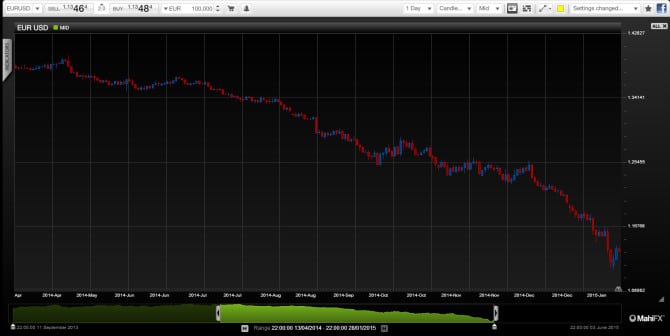SGD is the latest currency to register a sharp unexpected drop following action from the Monetary Authority of Singapore to ease monetary policy, which is fast leaving the US and Switzerland as the only two countries not trying to devalue their currencies.
The question is – how long will that last for?
Many of the recent moves and talk from central banks in Canada, Eurozone, Australia and India have been a reaction to falling prices of oil and other major commodities. Japan, meanwhile has fully engaged in debasing JPY for some time. So many countries pursuing action to keep their currencies weak only piles more upward pressure on those that are not subject to such policies – namely USD and CHF.
By Justin Pugsley, Markets Analyst MahiFX. Follow @MahiFX on twitter
The US Federal Reserve has been priming the markets for a rate rise for some time now, which along with the end of its quantitative easing programme has sent USD soaring. Looking at the history of the USD – extended multi-year rallies have happened before. A major one occurred in the late nineties and especially during the early to mid eighties when it soared. On the both occasions aggressively tightening monetary policy was a major driver.
EUR/USD – How much lower will US authorities tolerate? (currency chart below)
Why this rally may not be one of the big ones
Certainly all the fundamentals are in place for USD to potentially continue rallying throughout this year and possibly beyond. The US economy is actually growing and jobs are being created, which is in sharp contrast to most of the rest of the developed world.
However, there are a number of reasons to believe that this USD rally may not become one of the great rallies. The world has changed since the financial crisis of 2007-8 with perpetual uncertainty and now deflation being the new normal. Even the US economy’s recovery has not been particularly speculator by historical standards and it required the biggest monetary stimulus in US history.
Indeed, US interest rates may only rise modestly in the next few years, not giving much impetus for a long-term USD rally. Also, once the economic cycle turns downwards, the Fed could once again be resorting to QE.
Even the collapse in the oil price could impact US growth in mixed ways. The fracking industry has been a big money spinner. The hope is that the consumer will more than make up for the travails of the fracking industry and they should do. Already sales of large cars are up. A kind of wealth transfer from Houston to Detroit and to US shopping malls is taking place.
The other key factor is whether US policy makers are willing to allow USD to keep on rising. The USD index is around 94 having risen from just 80 at the beginning of the month. What if it were to hit 110 or 120? There could come a point where US policy makers begin to grow concerned about a strong USD due to the current account and US export competitiveness and decide that a low inflation backdrop is a good excuse to ease monetary policy – though they’re some way from doing that.
As for the Swiss – they introduced a negative interest rate of 0.75 when they unpegged CHF from the EUR to the consternation of the country’s business community. They’re not likely to tolerate an ever rising CHF and will look once again to burn speculators with some swift and unexpected action should they feel the currencies is rising too much.

